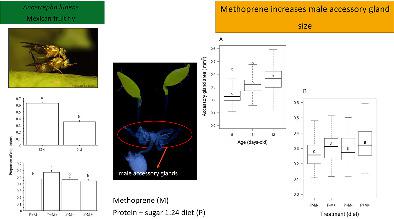当前位置:
X-MOL 学术
›
Physiol. Entomol.
›
论文详情
Our official English website, www.x-mol.net, welcomes your
feedback! (Note: you will need to create a separate account there.)
Feeding on methoprene increases male accessory gland size and body protein in the Mexican fruit fly
Physiological Entomology ( IF 1.6 ) Pub Date : 2021-02-18 , DOI: 10.1111/phen.12352 Martha Reyes‐Hernández 1, 2 , Ricardo Macías‐Díaz del Castillo 1 , Solana Abraham 3 , José Arredondo 4 , Diana Pérez‐Staples 1
Physiological Entomology ( IF 1.6 ) Pub Date : 2021-02-18 , DOI: 10.1111/phen.12352 Martha Reyes‐Hernández 1, 2 , Ricardo Macías‐Díaz del Castillo 1 , Solana Abraham 3 , José Arredondo 4 , Diana Pérez‐Staples 1
Affiliation

|
Methoprene, a juvenile hormone analog, accelerates male sexual maturation in some pest species controlled through the Sterile Insect Technique (SIT). The SIT consists of the mass‐rearing, irradiation and release of insects into affected areas, where sterile males mate with wild females and render them infertile. Sterile males are held for 6 days in confinement before release, and they are often released before attaining sexual maturity. The use of methoprene during this time has been shown to increase male mating frequency. However, very little is known on the effects of methoprene on the reproductive physiology of tephritid pests, including male accessory gland size, whole body protein content, sperm transfer and female remating receptivity. Here we found that sterile Anastrepha ludens males fed methoprene with only a 1:24 protein to sugar diet had greater male mating frequency and bigger male accessory glands compared to males deprived of methoprene. Furthermore, positive effects of methoprene inclusion in the diet were found on the amount of sperm stored by females, and body protein content but only when males fed sugar only. Inclusion of methoprene in the diet did not affect remating propensity of wild females having mated with sterile males. Females mating with young 5‐day‐old males stored fewer sperm than females mating with older males regardless of diet. The use of methoprene as a pre‐release supplement can positively impact early sexual maturation, energy reserves and male reproductive organs of A. ludens males, thus supporting its use in SIT programmes controlling this pest.
中文翻译:

喂食甲基戊二烯会增加墨西哥果蝇中雄性副腺的大小和体内蛋白质
Methoprene是一种幼年激素类似物,它可以通过不育昆虫技术(SIT)控制某些害虫中的雄性成熟。昆虫不育技术包括昆虫的大量繁殖,辐射和释放到受灾地区,在那里不育的雄性与野性雌性交配并使它们不育。雄性不育的男性在释放前要被关押6天,通常在性成熟之前就被释放。在这段时间内使用甲氧戊二烯已显示会增加雄性交配频率。但是,关于甲基戊二烯对甲状腺病虫害的生殖生理的影响知之甚少,包括雄性副腺大小,全身蛋白含量,精子转移和雌性对雌性的接受能力。在这里,我们发现无菌的Anastrepha ludens与不含甲氧戊丁的雄性相比,仅以1:24的蛋白质喂食甲基戊二烯糖饮食的雄性具有较高的雄性交配频率和较大的雄性副腺。此外,在日粮中加入甲基戊二烯对女性储存的精子量和人体蛋白质含量有积极作用,但仅在男性只喂糖的情况下。在饮食中加入甲氧戊二烯不会影响与不育雄性交配的野生雌性的再繁殖倾向。不论饮食如何,与5日龄年轻雄性交配的雌性比与老年雄性交配的雌性存储的精子少。使用甲基戊二烯作为预释放补充剂可以对A. ludens男性的早期性成熟,能量储备和男性生殖器官产生积极影响,从而支持其在控制该害虫的SIT程序中的使用。
更新日期:2021-02-18
中文翻译:

喂食甲基戊二烯会增加墨西哥果蝇中雄性副腺的大小和体内蛋白质
Methoprene是一种幼年激素类似物,它可以通过不育昆虫技术(SIT)控制某些害虫中的雄性成熟。昆虫不育技术包括昆虫的大量繁殖,辐射和释放到受灾地区,在那里不育的雄性与野性雌性交配并使它们不育。雄性不育的男性在释放前要被关押6天,通常在性成熟之前就被释放。在这段时间内使用甲氧戊二烯已显示会增加雄性交配频率。但是,关于甲基戊二烯对甲状腺病虫害的生殖生理的影响知之甚少,包括雄性副腺大小,全身蛋白含量,精子转移和雌性对雌性的接受能力。在这里,我们发现无菌的Anastrepha ludens与不含甲氧戊丁的雄性相比,仅以1:24的蛋白质喂食甲基戊二烯糖饮食的雄性具有较高的雄性交配频率和较大的雄性副腺。此外,在日粮中加入甲基戊二烯对女性储存的精子量和人体蛋白质含量有积极作用,但仅在男性只喂糖的情况下。在饮食中加入甲氧戊二烯不会影响与不育雄性交配的野生雌性的再繁殖倾向。不论饮食如何,与5日龄年轻雄性交配的雌性比与老年雄性交配的雌性存储的精子少。使用甲基戊二烯作为预释放补充剂可以对A. ludens男性的早期性成熟,能量储备和男性生殖器官产生积极影响,从而支持其在控制该害虫的SIT程序中的使用。









































 京公网安备 11010802027423号
京公网安备 11010802027423号